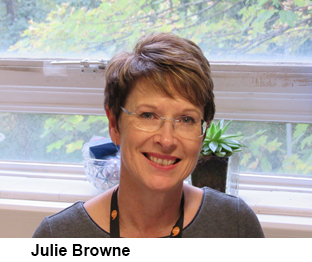by
Professor Alison Bullock, Julie Browne, Cardiff University
| Aug 24, 2020
We commissioned an independent team at Cardiff University to undertake a review of the research into health and care professional regulation since 2011. In this guest blog, Professor Alison Bullock and Julie Browne from Cardiff explain more about why we asked them to undertake the review and what it revealed.
Why we were asked to do the review
At the Professional Standards Authority’s academic and research conference in March  this year, Alan Clamp, the authority’s CEO said: 'Research makes a vital contribution to providing evidence for regulatory policy.' Indeed it does; but is the academic research base reliable, relevant and rigorous enough to meet regulators’ needs for high-quality evidence?
this year, Alan Clamp, the authority’s CEO said: 'Research makes a vital contribution to providing evidence for regulatory policy.' Indeed it does; but is the academic research base reliable, relevant and rigorous enough to meet regulators’ needs for high-quality evidence?
In January 2020, the Authority commissioned our team at Cardiff University to help answer this question by undertaking a review of the research into health and care professional regulation since 2011.
The three key objectives for the research were:
- To source research in the area of health and care professional regulation in English since 2011;
- To evaluate the research and draw out what it has taught us; and
- To identify any gaps in the research and areas that would benefit from deeper exploration to inform the focus of further research and continue to build the evidence base in relation to health and care professional regulation.
How we did the review
We began by asking the regulatory bodies themselves about their key research priorities, what research they conducted and how they obtained and used it. We reviewed regulators’ annual reports and other key strategic documents (‘grey literature’), supplementing this information with personal contacts and additional resources. Lastly, we conducted a review of the published peer-reviewed literature, screening over 3,000 articles for academic rigour and relevance to the regulators’ activities and research priorities. Careful sifting enabled us to settle on a final list of 81 for close analysis.
What we found
While regulators differ considerably in their size and resources, the overall picture is one of intense activity in the areas of policy development and data collection, with a mix of strategic research related to ‘core business’ and work done in response to emergent issues such as workforce concerns or high-profile cases. It wasn’t always clear how research priorities were decided and although most reported key pieces of work that had informed current or future work it was sometimes unclear how the impact of these influential projects had been evaluated. The review of the grey literature revealed regulators’ continued concern with the burden of fitness to practise processes and the related legislation, coupled with a variety of new measures to reduce workloads and support registrants through the process.
Exploration of the peer-reviewed literature revealed a variable mix of impact studies and more general publications. The impact studies rarely used experimental designs but were more clearly focused on gathering and interpreting data on the evaluation, effect, or implications of certain regulations. The general publications mostly provided overviews, snapshots of the current situation or discussions.
We identified six key themes. Papers on education and training generally called for greater standardisation and harmonisation across professions and internationally, with a focus on the challenges to education resulting from financial, workforce, clinical and political pressures at all stages of training.
A second group of papers presented analysis or comments on the functioning of guidelines and standards and the impact of changes in these, with most calling for more clarity and greater consideration of the effect of implementation.
The largest group of papers related to fitness to practise, misconduct, complaints and disciplinary procedures. Many of these were descriptive studies reporting the demographics, professions, numbers and types of complaints although a substantial number also looked at the potential causes of complaints (individual, environmental and cultural), highlighting challenges with the processes and the distressing effects on individuals.
Registration and maintenance of registration were the focus of a fourth group, which mainly addressed the potential flaws and inconsistencies in processes and systems which may lead to bureaucracy and bias affecting practitioners.
A further group addressed relations between registrants and regulators. While most appreciated the importance and benefits of regulation to patient safety and improved practice, these papers tended to focus on evidence that some registrants perceive regulators as remote, mistrusted, punitive, unsupportive and inconsistent both within professions but also across professions and regions. These arguments were chiefly used to underpin calls for regulatory reform and greater consultation and engagement with practitioners.
Last but definitely not least, the smallest group of papers considered harm prevention and patient safety, offering advice to leaders in managing risk and calling for more person-centred approaches to regulation and particularly to inspection processes as a way of reducing conflict and enhancing patient safety. This group of papers, like most of the others, called for more harmonisation and standardisation across professions and sectors.
What we concluded from the evidence
Our disappointing conclusion was that the vast bulk of published papers in the field of health and social care regulation are of only tangential relevance to the regulators, failing to address their primary concerns. Papers tended to be small-scale, local, and usually of low generalisability to other settings or professional groups. They often appeared to result from small-scale individual research projects or routine quality assurance processes. Of those that are relevant, most report or describe what is already happening, with few able to show effect or demonstrate how or why those effects are occurring. Regulators in health and social care are working hard to produce evidence for their own use, but they need to be able to leverage the scholarly literature more effectively to inform their research and policy agendas.
We ended our report by concluding that many of the challenges we faced in the conduct of this review reflect that the study of the regulation of professionals in health and care does not yet have a strong and well-defined identity as an academic discipline and, as a result, the published evidence is diffuse and difficult to locate, and of limited applicability to other contexts. Despite this, it is an extensive and growing field that is ripe for development.
Related material